공지사항
-
- '노란봉투'캠페인/국제연대..
- no chr.!
27개의 게시물을 찾았습니다.
S. Korea's "rulers" are to open new possibilities to escalate their ongoing struggle against the Korean Teachers and Education Workers’ Union(KTU) by using some kind of (well, let's say) psychological warfare, as yesterday's conservative bourgeois newspaper JoongAng Ilbo reported (of course not without an element of spitefulness):
Names of teachers in KTU to be released
The Korean Teachers and Education Workers’ Union has been a thorn in the side of local governments with its alleged political activities. But now the table might be turning.
Last Friday, the Seoul Central District Court dismissed a request by Education Minister Ahn Byong-man that the names of the union members not be made public. After the announcement, the Education Ministry said it had sent a list of the union member names to the National Assembly as requested.
Grand National Party lawmaker Cho Jeon-hyeok, also a member of the National Assembly’s education, science and technology committee, received the names. “By April 20, we plan to reveal the teachers’ names, their schools and subjects [they teach] on the Internet so that teachers and students will be able to find out about them easily,” he said.
Previously, students and parents were able to learn the total number of the union members through the Web site www.schoolinfo.go.kr However they now will be able to check whether the students’ teachers are associated with the union. This development has sent shock waves through the union. Officials say around 340 members have dropped out of the union since the court’s dismissal of the Education Ministry’s request. Shortly after its legalization in 1999, the union saw a rise in membership, reaching its peak in 2003 with 93,860 members. Since then, however, the number has dropped. By March of last year, the union had 69,530 members, or 20 percent of all teachers nationwide.
Since all civil servants and educational workers in Korea are banned from collective political activity, the union has said its members are simply exercising their rights to free speech.
Last year, the union held an anti-government protest and released a statement saying that the Lee Myung-bak administration was endangering democracy. Last month, police discovered that 120 union members and the Korean Government Employees’ Union had registered as members on the Democratic Labor Party Web site.
Police said they suspect the DLP collected around 17 billion won from the teachers and other civil servants.
Currently, the union is resisting the court’s ruling. Um Min-young, spokesman for the union said that the union will apply for another injunction against GNP lawmaker Cho to stop him from revealing member names. He said that doing so would be an invasion of and a breach of individual rights.
One union member said that “the ideological conflict that will surface in schools after the revelation of member names is unimaginable” adding that revealing the names of members is a means the government is using to destroy the union.
Many parents and school principals however, welcomed the new plan. Chae Hyo-jin, 41, a mother of a child in high school said that she “will be able to prepare for any circumstance [regarding her child’s education] only when I know the political tendencies of the teachers.”
Lee Nam-yeong, head of the teachers’ cooperation division at the Education Ministry said, “I doubt that a movement [by parents] to refuse letting a teacher [educate their children] will surface, but this new revelation will make it possible for parents to check what kind of education their children are getting.”
http://joongangdaily.joins.com/article/view.asp?aid=2918516
Pyongyang's "rulers" are very well-known for their special sense of perfect - mostly very empathic - timing for the release of statements, threatening the rest of the world...
Yesterday, while the (S. Korean) "public angst was building at the lack of success in rescuing missing sailors from a sunken patrol ship" (Yonhap), it was KPA's turn to scare the S.K. public(*), as KCNA(3.29) reported:
KPA Warns Any Act of Disturbing Security and Order in DMZ
These days witness a lot of serious developments in the area along the Military Demarcation Line where huge armed forces are standing in acute confrontation for which the south Korean military authorities are to blame. They may drive the present touch-and-go situation to a more dangerous phase.
A spokesman for the Panmunjom Mission of the Korean People's Army issued a statement on Monday in this regard:
The south Korean military warmongers have been busy staging an anti-DPRK psychological warfare in the Demilitarized Zone with agents specializing in this warfare and other riff-raffs involved since the mid-February under the signboards of "visit," "tour" and "observance".
It is a well-known fact that the south Korean military concluded what it called "MOU on supporting news coverage of the DMZ" with 15 media organizations in a bid to let their reporters tour not only the DMZ but nearby frontline areas and prepare materials for anti-north smear campaigns and release them by means of newspapers, broadcasting services, internet, etc.
As already known to the world, Paragraph 9 of Article 1 of the Armistice Agreement stipulates that "No person, military or civilian, shall be permitted to enter the Demilitarized Zone except persons concerned with the conduct of civil administration and relief and persons specially authorized to enter by the Military Armistice Commission."
It is preposterous for the U.S. and south Korean sides to allow those who have nothing to do with the civil administration and relief to enter the DMZ, given that the Military Armistice Commission was completely demised and the military machines of both sides tasked to supervise and control the implementation of the AA in place of the commission have not been in existence for nearly two decades due to the deliberate moves of the U.S. to scrap the AA.
In the final analysis, all these moves of the south Korean military warmongers cannot be interpreted otherwise than deliberate acts to turn the DMZ into theatre of confrontation with the DPRK and a site of psychological warfare against the north in disregard of the AA and strain the overall situation on the Korean Peninsula.
The U.S. is a signatory to the AA and responsible for implementing it.
It is, therefore, obliged to stop the moves of the south Korean military authorities to misuse the DMZ for meeting their sinister purpose.
The U.S. side should cogitate about the grave situation in which the security and order in the DMZ which have so far been observed for form's sake are disturbed and this area is turning into a total military zone and a theatre of inter-Korean confrontation and a site of psychological warfare against the north in contravention of the AA.
The Panmunjom Mission of the KPA clarifies the following principled stand to cope with the prevailing situation:
1. The U.S. side should force the south Korean authorities and military warmongers to halt at once their moves to disturb the security and order in the DMZ if it is interested in the peace and security on the peninsula as a signatory to the AA.
2. The south Korean military warmongers should roll back without delay their foolish plan to turn the DMZ into a theatre of confrontation with the DPRK and a site of psychological warfare against the north and stop their rash acts, if they want to escape the unexpected strike of the KPA.
3. If the U.S. and the south Korean authorities persist in their wrong acts to misuse the DMZ for the inter-Korean confrontation despite our warnings, these will entail unpredictable incidents including the loss of human lives in this area for which the U.S. side will be wholly to blame.
Intolerable is any act of disturbing the security and order in the DMZ.
http://www.kcna.co.jp/item/2010/201003/news29/20100329-01ee.html
* Interpretation by K. Times: "NK Warning to Scare Away DMZ Tourists"/"Naughty N.K. scaring the tourists. Bad North Korea. Bad.", note by The Marmot's Hole(3.30)
Malaysia:
Massive Exploitation and Oppression of Migrant Workers, Combined with Manhunt and Mass Deportation
Last week Amnesty International(AI) accused Malaysia(MAL) over migrant workers abuse, but the Malaysian gov't - surprise, surprise(!!) - is ignoring AI's demand to reform its migrant worker law...
Today the Nepali Nagarik Daily reported that the Malaysian "authorities" have arrested, partly by using massive violence, over 500 Nepali un-documented migrant workers (among hundreds migrants from other South Asian countries) in the recent days.
The "authorities" started an operation named 'Sweep Operation' from February 24 to curb the "illegal" migrant workers.
Malaysian detention center: captured migrant workers
It is estimated that there are about one million un-documented migrant workers (according to al-Jazeera) with about 50,000 from Nepal alone.
Migrant workers in Malaysia - mainly employed in construction sites, factories, restaurants and palm oil plantations - are subject of massive exploitation and oppression...
According to AI large numbers of migrants find when they arrive that they are given lower-than-promised wages and forced to work in unsafe conditions.
It said arbitrary arrests and extortion were other common complaints.
While many Malaysian firms depend on a large supply of migrant labour, "Migrant workers come to Malaysia to escape poverty and to provide for their families. Once they arrive, however, many workers toil in conditions that amount to labour exploitation," AI said in its latest report.
Sounds somehow familiar, doesn't it? It's almost comparable with the situation of migrant workers in S. Korea (and many other countries)...
For more please check out:
☞ Malaysia must end abuse of migrant workers (AI, 3.24)
Y'day the German (conservative) daily newspaper Die Welt wrote the following:
Conflict with the South
Warship sinks - North Korea possibly not involved
On Friday, according to the (South Korean) Ministry of Defense, an unexplained explosion in the ship's stern tore the vessel in two after it fired off a warning shot at an "unidentified object". But the object wasn't a North Korean naval ship, as primarily supposed, instead it was very likely a flock of birds...
And the moral of the story? Never try to attack the infamous species of the "North Asian Torpedo Seagull"!!

The 'Cheonan', before it attacked "a flock of birds"...
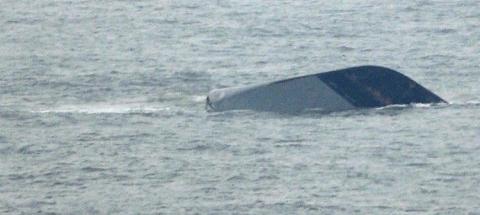
...and afterwards - bottom up
If you want to follow an interesting (??) discussion about the possible cause of the incident, please check out the related contribution on OFK!
Related article:
☞ Speculations vary on cause of ship sinking (K. Herald, 3.28)
"Enjoy" (well, you should memorize!!^^) the weekend lesson, entitled:
The Youth Captain, Comrade Kim Jong-eun is a Mt. Baekdu style of captain who bears the perfect dignity and qualifications of the great men in history and carries on the ideology and leadership of the Great General (*)
1. The Youth Captain, Comrade Kim Jong-eun is a good model of loyalty, one who displays the highest level of loyalty to the Great General (aka Kim Jong-il).
1.1 He is the one who faithfully carries forward the achievements of the Military-first revolution, which the Great General has enhanced.
2. The Youth Captain, Comrade Kim Jong-eun is a great figure who presents the ideology and appearance of the Great Leader (aka Kim Il-sung) and the Dear Leader.
2.1 He is a master of ideology and theory who has inherited the General’s nature.
3. The Youth Captain, Comrade Kim Jong-eun is a remarkably talented person who bears all the ability of a great general, which the Great Leader also bore.
3.1 He harbors military genius and leadership qualities as well.
4. The Youth Captain, Comrade Kim Jong-eun has all the human qualities, which are eternally moderate.
4.1 He is the one who takes care of the people’s lives with a warm heart and love.
5. The Youth Captain, Comrade Kim Jong-eun is well-versed in the Juche Ideology, military science, Juche politics and economics, Juche literature and arts.
5.1 He has a wide knowledge of all other fields like world politics, economics, the military and culture.
* "Education" material(**), released in late January for KWP cadres and KPA officers.
** Please keep in mind that absolutely nobody in the N.K. public (except a very tiny group around the "Dear Leader"/but of course they've nothing to do with the N.K. public!) knows something about the (f*cking)"Youth Captain, Comrade Kim Jong-eun"...
Somehow related:
☞ Signs of Big Bang in North Korea? (K. Times, 3.25)
☞ N. Korea threatens 'nuclear strikes' on S. Korea, US (AP/Ynet, 3.26)
☞ US-S. Korean Moves to Bring down System in DPRK Warned (KCNA, 3.26)
Today's Hankyoreh is reporting the following:
Gov't employees fired for KGEU launch ceremony
MOPAS is banning all KGEU activities in an effort to prevent the union from functioning
The Lee Myung-bak administration has decided to dispense heavy-handed punishments to the government employees who attended the launching ceremony of the Korean Government Employees’ Union (KGEU) and a rally of union leaders on March 20 and expel union leaders who actively participated from public office. The KGEU said the launching ceremony is an event that has been held annually since 2003, and that the Lee administration is misusing its authority to hand out heavy punishments without asking questions in order to repress government employee unions critical of the government.
The Ministry of Public Administration and Security (MOPAS) said Wednesday that KGEU, which had its foundation notification documents returned on two occasions by the Ministry of Labor, had violated the law by pushing though with a launching ceremony after issuing protests. MOPAS said it has made the decision to fire 18 union leaders, including 13 headquarters heads including KGEU Vice Chairman Park Yi-jae (an employee at Masan City Hall) and Secretary General Ra Il-ha (an employee at Anyang City Hall). It also plans to punish all government employees who attended the rally after confirming their identities. Union Chairman Yang Seong-yun (an employee of Seoul’s Yangcheon-gu Office) was fired by Seoul City Hall in November of last year for violating the legal ban on civil servants engaging in collective actions by taking part in a rally to “condemn government repression of government employee unions” in July of the same year.
MOPAS regards the KGEU as an illegal group and is not allowing any activities to take place under that name. Lee Song-ok, head of MOPAS’s Civil servant Association Policy Division, said MOPAS plans to block KGEU branches from establishing offices and said union offices currently using the KGEU name must take down their signs. It also banned government employees from hanging banners or posters with the KGEU name, distributing so-called “propaganda materials” using the KGEU name, or holding picket demonstrations using the KGEU name. If the union homepage is run under the KGEU name, it will be blocked at offices. If a government employee does violate one of these regulations, MOPAS has decided it will levy up to 5 million Won ($4,384) in fines in accordance with the Labor Union and Labor Relations Mediation Law. By banning all activities under the KGEU name, the ministry has virtually rendered the union unable to function.
In response, KGEU spokesman Yun Jin-won said the Lee Myung-bak government’s attempt to kill the government employees union has reached an extreme level. Yun said a launching ceremony is a right of the union, and to regard this as illegal and severely punish participants is unjust. In response to MOPAS’s decision to designate KGEU as illegal, Yun said KGEU is not illegal, but rather a union currently preparing to be founded. He said the union filed a suit on March 9 in an administrative court to overturn the Labor Ministry’s atypical decision to return KGEU’s foundation notification documents, and until the court issues a decision, the union is legal.
The notification system was created as part of a system to recognize that workers were forming unions as part of their Constitutionally-guaranteed rights. No one is required to obtain permission from the government to exercise his or her Constitutional rights, and prior to the Lee administration, notifications of new unions have been accepted, as long as there have been no serious problems.
Meanwhile, the Labor Ministry, which twice returned the KGEU’s foundation notices in December of last year even though the notices are not supposed to undergo fierce scrutiny, returned its foundation notification documents a third time on Wedensday, saying KGEU could be disqualified because previously fired employees and duty managers are eligible to sign up and participate.
http://english.hani.co.kr/arti/english_edition/e_national/412231.html
Related article:
☞ Gov't to dismiss unionized civil servants for illegal rally (Yonhap, 3.24)
MTU published y'day the following survey:
Migrant Workers in S. Korea - History and Reality
Migrant Workers Background
The MOU between Korea and the EPS sending countries have varied qualification requirements for each country. In some countries being a highschool level or graduate is enough to apply as workers in Korea. But for some countries they require workers to have at least some college level education or trade/vocational graduates.
However, due to the high costs of migration and the high education level of most job seekers, a large majority of the migrant workers who came to Korea have had a higher degree of education (sometimes professionals), or had long term employment in manufacturing industries, were also migrant workers from other countries or belonged to the lower middle class families. The very poor cannot access financial sources to process their application requirements because they have no collateral for loans, families cannot give financial support or they are credit risks (no regular or long term employment).
Some migrants came here on tourist visas or family invitations. Now, most are hired through the Employment Permit System or EPS, entertainers visa, some professionals get working visas. Some people also come here on student visas.
Since most of the workers are industry based, most of the workers are male and around one third female.
Majority believe that they will only stay here temporarily.
Majority support immediate and extended families. (Wife, children, parents, siblings and other relatives).
Migrants are immediately given a higher social standing in the community and therefore are given a higher social responsibility. Therefore, in emergency situations they are usually looked upon in the community as a source of help or assistance.
The age bracket for migrants are 20-45 years old. Many have families of their own.
Most migrants are aware of the difficulties of working in Korea through the pre-departure training/education requirements.
Majority of the migrant workers directly and indirectly suffer from labor violations but a high majority of the workers fail to realize or know that there rights are being violated. Even if they knew that their rights are being violated most migrant workers are not aware what they should do.
Language is the primary barrier for migrants in seeking redress and correction for their violated rights.
Even if migrants knew what to do or they completely knew the process in taking corrective actions or measures the law is designed to protect the workplace and employers than protection of the workers.
There is no job security for migrant workers, very limited opportunity to change workplaces even under unfavorable or abusive conditions.
Most have to endure slave-like conditons: unpaid wage, underpayment, salary cuts, huge pay deductions, forced labor, verbal abuse, long working hours, not enough rest time, not enough rest days, no sick leave or vacation leave, illegal termination, no benefits, contract violations, industrial accidents, health issues, physical abuse, deplorable working and living conditions and all sorts of discrimination, limited access to health care and sometimes even prevention of their access to medical checks and treatment, women are highly susceptible to sexual violence and harassment, and all forms of discrimination. The undocumented workers suffer from all these and much more. The crackdown, criminalization, inability to seek redress against crimes committed against their person, limited mobility, stress due to uncertainty (their job, stay and status), could not easily go home because of the inability to return, loved ones dying and being uncapable of seeing their loved ones one last time, loved ones getting sick, and so much more.
Most migrants intention is to work abroad only for a few years in order to save up enough money to use as capital for businesses back home. Others, to support the education of their children or siblings. Others to provide support for the medical treatments of loved ones. A few handful of people come to seek independence financial and/or social independence. And some intend to save up enough money in order for them to be able to immigrate to another country.
Lack of knowledge either in labor law or language are the usual reasons why the migrants are abused. Migrants are threatened with termination or repatriation to the home country if we do not follow or endure the working conditions in a company. The limitations in the law also gives way to abuse.
Results of migration on the life of the migrant workers:
Migrant workers would come to Korea in the hope of securing a better future for themselves and their families. Being economically and financially disadvantaged, workers would risk their health and quality of life to sacrifice not only for the family but for our countries as well. Our earnings help to keep our nations economies afloat.
Injuries and illnesses vary depending on the nature of work. Repetitive stress injuries, respiratory diseases, accidents like amputations, sleep deprivation, organ failures and ailments, blood poisoning, heavy metal poisoning, nerve damage, psychological stress, and many other ailments and illness.
De-humanization of the migrants. Most migrants are treated like machines or animals in the workplace. We are always expected to work harder longer and faster than the native workers. Our accomodations are either too cramped, dirty, not suitable for living, expensive or all of the above. We are usually housed inside the company premises so that they are easily accessible. We are deprived of adequate rest because of the noise, extremely cold/hot rooms, dirty environment or too much work load.
Common problems arise from separation of the families. Extra-marital affairs, broken marriages, lack of parent figure, low self-esteem for the children or puts a higher value on materialism over relations, vices, lack of communication and an overall stress on relationships.
The prime of the migrant workers life is spent in doing hard labor and rarely does the migrant worker go back to the homeland completely free from illness or injury. The savings, if the migrant is able to save would usually be spent on medication and treatment, or the quality of life is extremely reduced, or would not be enough to secure a decent life.
Because of the limitations of the law in the protection of the migrant workers rights the system continuously threaten the job security of the workers. It has also institutionalized the abuse of the migrant workers despite of laws put into place. The contradiction of the immigration law and labor law make it difficult for the migrant workers to enjoy their full labor rights. The systems policy is also a vehicle for the migrant workers loss of status. These in turn only perpetuates the existence of undocumented workers in Korea. The system also aims to keep the migrant workforce temporary by making the working periods shorter so that they may easily exploit the migrant workers. This limits their ability to adapt, educate themselves, achieve empowerment and experience. In short they aim to keep the migrant workers submissive to their employers instead of call for better working conditions. Complaining about the bad conditions in the workplace easily endanger our job security, our visa status or repatriation.
Discrimination is commonplace in the Korean work environment as well as the society in general. The negative stereotyping of migrants like hygiene, criminality, ignorance, uneducated, poor, barbarism or the lack of social graces are the most common stereotypes for migrant workers. These stereo-typing generally paves the way for the discrimination of the migrants. Undermining the values of our humanity, we are then treated as sub-human as what is reflected in our working conditions and living conditions.
Short History of Migrants in SK
During the latter part of 1980's through the early 1990's it was notably visible that there was a sudden influx of migrant workers to South Korea. Concurrent with Korea's economic boom, the 1998 Olympics gave light to the fact that the Korean Industry is an employment opportunity for foreigners whose native countries have a high rate of unemployment and limited opportunities. The Korean Small and Medium Scale Enterprises are in dire need of this labor force because native workers refuse to work for these companies given that typically the work would be dirty, difficult or dangerous, what is otherwise known as 3D jobs.
Migrant labor came from as far as the African continent but majority of these workers came from poorer Asian neighbors. Around half of the foreign population in Korea are Chinese or Chinese-Koreans. The rest are from the 14 other EPS sending countries and others (Russia, Mozambique, Ghana, India, Peru, etc.). Asylum seekers and refugees, F2 visa holders or Korean spouses can also be considered as part of the migrant workforce since they are also employed in these industries and it is quite difficult for a foreigner married to a Korean to get citizenship and are deemed of lower stature than native Korean workers.
Before the Employment Permit System came to being, the Trainee System of employment was introduced in Korea around the 90's. This system was used to manage the migrant labor force that was growing in Korea during that time . The trainees, as they were called were not entitled to same the labor rights of Korean workers and thus, discrimination and abuse led to the rise of undocumented migrant worker population. Because of heavy criticism from social groups and communities who are sympathetic to the migrant workers, the Government drafted a new system of employment, which we now know as the Employment Permit System or EPS. None the less, migrant workers and some Korean social groups criticized EPS as still being too restrictive. These criticisms and other abuses like the crackdown led the migrant workers and Korean social groups to conduct a sit-in struggle in front of the Myeong-dong Cathedral protesting the lack of protection of migrant workers and being treated as disposable labor.
The EPS was first put in effect in 2004 and up to now is still being currently used as a system of employment for migrant workers. For the EPS workers, the employment policy restriction of limiting the work place change to only 3 times is a primary deterrence for the migrant worker to exercise their rights. Given the severity of the repercussions like losing their legal visa status, they would rather put up with the sub-standard work and living conditions. In principle, the EPS workers are on an equal footing as native workers. In reality, the policy restrictions are paving the way for abuse both physical and verbal, forced labor, excessively long work hours, not enough rest hours/days, unpaid wages, huge pay cuts, denied benefits and more. The policy restrictions serve as the invisible chain that binds them in servitude to their employers. The EPS policy on migrant workers is an ineffective tool in securing the Labor Rights and Human Rights of the migrant worker. It has not only encouraged employers to abuse their migrant workers this system also helps perpetuate all forms of abuse against EPS migrant workers.
It is especially hard for EPS workers to secure their rights under the current system but for undocumented migrant workers it is nearly impossible. Undocumented workers are criminalized in Korea. The current Crackdown against undocumented migrant workers is obviously a transgression on their humanity. Productive individuals who have contributed to the economy of Korea are treated no better than ordinary criminals. The Crackdown has led to several deaths, injuries, loss of livelihood and deep mental and emotional stress. Crimes committed against undocumented migrant workers are more often than not remain unresolved and are not given justice because the victims(undocumented workers) are the ones treated as criminals. * (cite as example: undocumented Filipina worker stabbed, undocumented Filipino worker turned over to the immigration after filing a complaint for being beaten up.)
http://migrant.nodong.net/?document_srl=26795#0
Of course not only in S. Korea migrant workers are subjects of massive exploitation and oppression, as you can read in the following article:
☞ Malaysia accused over migrant abuse (al-Jazeera, 3.24)
Well, it might be that there are possibly some good(*) news for Seoul's Filipino Market, aka "Little Manila":
The market for the Filipino community held every Sunday, is being allowed to stay at Hyehwa-dong, at least for now, according to Jongno-gu(District) Office.
* But be careful! Because the announcement by Jongno-gu Office to "closely monitoring" the market sounds more like a veiled threat as a sign of understanding, resp. an official approval...
Related articles:
☞ "Little Manila" can stay, for now (Hanopolis, 3.19)
☞ 'Little Manila' to Stay On (Korea Times, 3.18)
☞ Saving Korea's 'Little Manila’ (JoongAng Ilbo, 3.08)
Last Thursday the S. Korean gov't "warned firm action against a rally scheduled by an outlawed public workers' union, calling it 'an illegal collective action.'", according to Yonhap (3.19). "The government will deal sternly with civil servants participating in the rally in accordance with the law and principle, having concluded that it is an illegal collective action," the Ministry of Public Administration and Security(MOPAS) said in a statement. "Anyone found to have participated in the rally will be punished without exception." a MOPAS official announced.
But despite this implicit threat by the LMB administration more than 600 members of the now-united Korean Government Employees Union (KGEU) hold last Saturday their launching ceremony at Seoul Nat'l University:

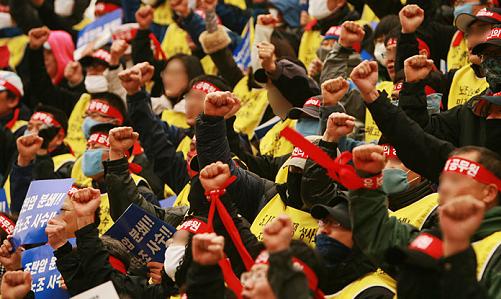

And now - surprise, surprise!! - the gov't will retaliate, likely mercilessly:
MOPAS announced y'day, “The launching ceremony ... was in clear violation of Article 66 of the Public Official Act and Article 58 of the Local Government Public Official Act, which bans collective action.” And it added, “MOPAS will issue a strong response in the interests of maintaining law and order.”
For more info please check out LabourStart!
Related report:
☞ 정부 봉쇄 뚫고 전국공무원노조 출범 (KCTU, 3.21)
1960.3.21: The Massacre in Sharpeville
Today marks the 50th anniversary of the day that changed the course of the South African history. When police forces hunted and a short while later opened fire on thousands of unarmed fleeing protesters, killing 69 and injuring at least 180...
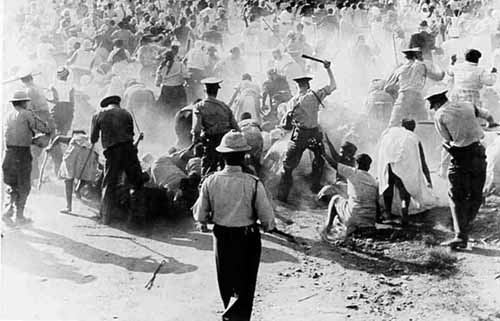

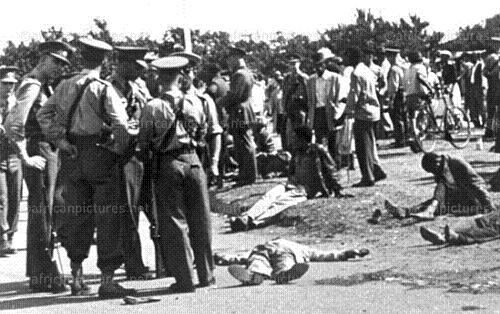
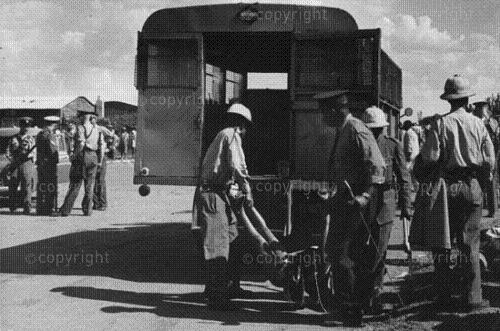
...they inadvertently provided a catalyst for decades of (armed) liberation struggle and forced the rest of the world to confront the iniquity of apartheid. White minority rule finally collapsed in 1994. Two years later it was in Sharpeville that the country's first black president, Nelson Mandela, signed a new constitution.
Related articles:
☞ Sharpeville: Legacy of a massacre (al-Jazeera, 3.21)
☞ Sharpeville 50 years on: 'At some stage all hell will break...' (Guardian, 3.19)
최근 덧글 목록